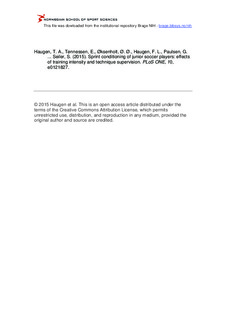| dc.contributor.author | Haugen, Thomas | |
| dc.contributor.author | Tønnessen, Espen | |
| dc.contributor.author | Øksenholt, Øyvind | |
| dc.contributor.author | Haugen, Fredrik Lie | |
| dc.contributor.author | Paulsen, Gøran | |
| dc.contributor.author | Enoksen, Eystein | |
| dc.contributor.author | Seiler, Stephen | |
| dc.date.accessioned | 2015-08-06T11:27:54Z | |
| dc.date.available | 2015-08-06T11:27:54Z | |
| dc.date.issued | 2015-03-23 | |
| dc.identifier.citation | PLoS ONE. 2015, 10, e0121827 | nb_NO |
| dc.identifier.uri | http://hdl.handle.net/11250/295226 | |
| dc.description | © 2015 Haugen et al. This is an open access article distributed under the terms of the Creative Commons Attribution License, which permits unrestricted use, distribution, and reproduction in any medium, provided the original author and source are credited | nb_NO |
| dc.description.abstract | The aims of the present study were to compare the effects of 1) training at 90 and 100% sprint velocity and 2) supervised versus unsupervised sprint training on soccer-specific physical performance in junior soccer players. Young, male soccer players (17 ±1 yr, 71 ±10 kg, 180 ±6 cm) were randomly assigned to four different treatment conditions over a 7-week intervention period. A control group (CON, n=9) completed regular soccer training according to their teams’ original training plans. Three training groups performed a weekly repeated-sprint training session in addition to their regular soccer training sessions performed at A) 100% intensity without supervision (100UNSUP, n=13), B) 90% of maximal sprint velocity with supervision (90SUP, n=10) or C) 90% of maximal sprint velocity without supervision (90UNSUP, n=13). Repetitions x distance for the sprint-training sessions were 15x20 m for 100UNSUP and 30x20 m for 90SUP and 90UNSUP. Single-sprint performance (best time from 15x20 m sprints), repeated-sprint performance (mean time over 15x20 m sprints), countermovement jump and Yo-Yo Intermittent Recovery Level 1 (Yo-Yo IR1) were assessed during pre-training and post-training tests. No significant differences in performance outcomes were observed across groups. 90SUP improved Yo-Yo IR1 by a moderate margin compared to controls, while all other effect magnitudes were trivial or small. In conclusion, neither weekly sprint training at 90 or 100% velocity, nor supervised sprint training enhanced soccer-specific physical performance in junior soccer players. | nb_NO |
| dc.language.iso | eng | nb_NO |
| dc.publisher | plos.org | nb_NO |
| dc.subject | sports | nb_NO |
| dc.subject | human performance | nb_NO |
| dc.subject | heart rate | nb_NO |
| dc.subject | acceleration | nb_NO |
| dc.subject | blood | nb_NO |
| dc.subject | velocity | nb_NO |
| dc.subject | running | nb_NO |
| dc.subject | strenght training | nb_NO |
| dc.title | Sprint conditioning of junior soccer players: effects of training intensity and technique supervision | nb_NO |
| dc.type | Journal article | nb_NO |
| dc.type | Peer reviewed | nb_NO |
| dc.subject.nsi | VDP::Mathematics and natural science: 400::Basic biosciences: 470 | nb_NO |
| dc.subject.nsi | VDP::Agriculture and fishery disciplines: 900::Agriculture disciplines: 910 | nb_NO |
| dc.source.journal | PLoS ONE | nb_NO |
| dc.description.localcode | Seksjon for fysisk prestasjonsevne / Department of Physical Performance | nb_NO |
